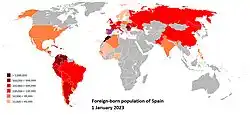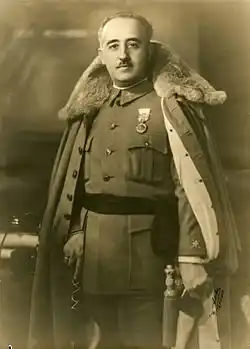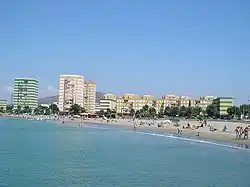
Immigration to Spain is the manner in which people have migrated to live in Spain in modern times. This is a relatively recent phenomenon linked to the development of the tourist industry. Prior to the development of this Spain was an economically backwards country and also one that was ruled by the dictatorship of Francisco Franco for nearly forty years in the middle of the twentieth century, all issues that dampened immigration to the country. Since the mid-1970s the tourism sector has ballooned, bringing with it large influxes of tourists, but also expats from other parts of Europe that have settled here permanently. Many seasonal tourist workers have also laid down roots in the country. Because of its long and expansive colonial history, Spain has also experienced migration from Latin America. This has been particularly acute in times of crisis and there has, for instance, been a large influx of Venezuelans since the early 2010s owing to the hyperinflation and political instability which has beset that country. Owing to its proximity to the Maghreb, Spain also experiences immigration from many parts of northern and western Africa, particularly Morocco. Today the foreign-born population of Spain is around 17%.[1]
Research your ancestors on MyHeritage
Immigration to Spain chronology of eventsImmigration to Spain chronology of events

Historically Spain has been a net exporter of people to the world. There are hundreds of millions of people in South America, Central America, the Caribbean and the Philippines today who are either of Spanish descent to one degree or another, or who speak Spanish, that attest to the concerted way in which Spanish people emigrated overseas and colonized large parts of the world between the sixteenth and eighteenth centuries. That trend continued into the nineteenth century, though it slowed comparative to the rise of emigration levels to the Americas from other European countries at that time. Then the twentieth century saw Spanish emigration dry up altogether as the population stopped expanding with the speed which it once had.[2]
The shift towards inward immigration into Spain in modern times represents an inversion of Spain’s migratory story. It is closely connected to political and economic developments in the post-war era. The Spanish Civil War, fought between 1936 and 1939, had brought the corporatist Falange government into power, with General Francisco Franco as a broadly fascist military dictator.[3] However, Spain did not join the Second World War alongside its sometime allies, Nazi Germany and fascist Italy, and in the 1950s, as Western Europe moved past the conflict towards a more liberal democratic stance, the Franco regime softened its political stances. By the 1960s it was actively trying to foster a tourist industry to address Spain’s centuries-long economic backwardness. The country’s warm weather, long beaches and good food combined with the rise of cheap commercial air travel to see a boom in tourism.[4]

These beginnings were further facilitated by the death of Franco in 1975 and the transition to a parliamentary monarchy. In 1986 the country joined the European Economic Community, the forerunner of the European Union, a move which further fuelled the growth of tourism. As a result, Spain has developed the largest per capita tourist industry in the world. This revolutionizing of Spain’s economy created the foundation for modern immigration to the country. Tourism created jobs and in particular a need for cheap seasonal workers.[5] These arrived from parts of Spain’s former empire in the Caribbean, Central America and South America, as well as other parts of Europe and North and West Africa. Morocco has been a particularly large source of this tourist labor. Furthermore, tourism soon led to the growth of expat communities of regular tourists who decided to abandon the rain of Northern Europe and settle in the sun of southern Spain permanently. Large numbers of these expats are people from Britain, while ultra-rich tourist towns like Marbella have attracted wealthy immigrants to Spain from places like Russia and the Middle East.[6]
Finally, political crises in other parts of the world have fuelled immigration to Spain in recent decades. Strangely, despite the short distance from Morocco to Spain across the Straits of Gibraltar, Spain was not as much at the coal face of the European Union migration crisis of the mid-2010s, during which Greece and Italy in the Mediterranean were very much at the coalface of the crisis. Nevertheless, it still experienced a large influx of people from Syria, Afghanistan and Iraq.[7] Desertification caused by climate change and political instability in the Sahel are also driving migration to Spain from countries like Mali, Chad, Niger and Burkina Faso. The expansion of Russia’s war in Ukraine in 2022 led to the resettlement of millions of Ukrainians around Europe and Spain took in a substantial proportion of these, while the hyperinflation and political crisis in Venezuela since the 2010s and other Latin American crises like the Colombian armed conflict have also seen hundreds of thousands of migrants arriving to Spain from South America in the early twenty-first century.[8]
Extent of immigration to SpainExtent of immigration to Spain

The extent of this migration has been truly enormous, though it can be hard to put exact figures on it for the reason that so much of it is transient. Hundreds of thousands of migrant workers have settled in southern Spain at a given time, often working in the country’s bustling hotels and restaurants, but not all remain permanently in Spain. Some will work there for a few years before moving onwards. Even expats will often return home after a sustained period of time living in the sun. Nevertheless, these make large contributions to Spain’s demographic makeup. There are, for instance, around 300,000 British expats living in Spain today.[9]
The country has taken in over 200,000 Ukrainian refugees between 2022 and 2024. There are believed to be upwards of half a million Colombians living in Spain as a result of the political and economic instability of their home country since the 1960s, while Venezuelans are the fastest growing minority in Spain. Hundreds of thousands have settled in Spain since Hugo Chavez seized power in Venezuela back in the late 1990s, while the economic collapse of the country under Nicolas Maduro since 2013 has led to the exodus of millions of Venezuelans from their homeland, a significant proportion of which have settled in Spain.[10]
Demographic impact of immigration to SpainDemographic impact of immigration to Spain
The demographic impact of all of this immigration to Spain has been immense. Back in 1975, when Franco died and the country began transitioning to democracy, the percentage of the population of the country that was foreign-born was negligible. It grew considerably in the last quarter of the twentieth century, but it is really in the last 25 years that things have changed dramatically. Today approximately 17% of the Spanish population were born outside of Spain and a significant number are second-generation migrants. To further compound the demographic shift, younger Spaniards are leaving the country in search of better jobs in other parts of Europe, as youth unemployment is very high in Spain. Hence, Spain is operating a revolving door, taking in large amounts of people from many countries and yet losing much of its younger population to Northern Europe. In decades to come tens of millions of people will have an ancestor who moved country because of these migratory phenomena, either to or from Spain.[11]
See alsoSee also
Explore more about immigration to SpainExplore more about immigration to Spain
- Spain, Telephone Directories records collection on MyHeritage
- Spain Newspapers from OldNews.com records collection on MyHeritage
- Spain, Baptisms, 1502-1940 records collection on MyHeritage
- Spain, Marriages, 1565-1950 records collection on MyHeritage
- An Introduction to Spanish Surnames at Legacy Family Tree Webinars
- Top 5 Resources to Expand Your Spanish Genealogical Research at Legacy Family Tree Webinars
References
- ↑ https://www.realinstitutoelcano.org/en/analyses/immigration-employment-productivity-and-inequality-in-spain/
- ↑ https://www.worldhistory.org/Spanish_Main/
- ↑ https://www.history.com/topics/world-war-ii/francisco-franco
- ↑ Sasha D. Pack, ‘Tourism and Political Change in Franco’s Spain’, in Nigel Townson (ed.), Spain Transformed: The Late Franco Dictatorship, 1959–1975 (New York, 2007), pp. 47–66.
- ↑ J. A. García-Barrero, ‘The formation of the tourism labour market in Spain, 1955–1973’, in Journal of Iberian and Latin American Economic History, Vol. 42 (2024), pp. 269–299.
- ↑ Erik Olsson and Karen O’Reilly, ‘North-Europeans in Spain’, in Nordic Journal of Migration Research, Vol. 7, No. 3 (2017), pp. 133–138.
- ↑ https://ec.europa.eu/programmes/erasmus-plus/project-result-content/84caa27a-b8fe-4927-af9e-2298b403477c/Refugees_situation.pdf
- ↑ https://www.scielo.org.mx/scielo.php?pid=S1665-89062021000100104&script=sci_arttext&tlng=en
- ↑ https://www.statista.com/statistics/1092654/british-population-spain/
- ↑ https://ec.europa.eu/programmes/erasmus-plus/project-result-content/84caa27a-b8fe-4927-af9e-2298b403477c/Refugees_situation.pdf
- ↑ https://www.migrationpolicy.org/article/spain-immigration-system-evolution

